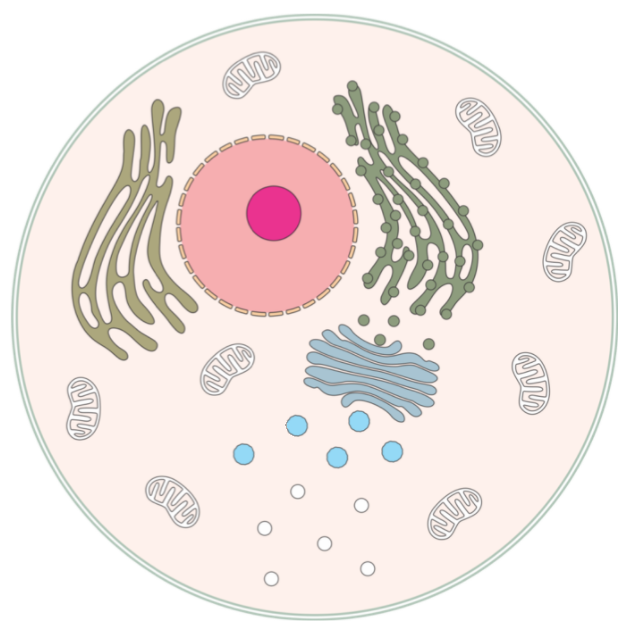Harvard Human Anatomy - Cells, Tissues and Systems
Cell: The smallest independent unit of living tissue. Cells are composed of molecules and organized by membranes. Below is an illustration of an animal cell
Cell membrane: A selective barrier between the interior and exterior of the cell.
Circulatory System: The body system that distributes body fluids, enabling transport of oxygen and nutrients to tissues and removal of CO2 and waste.
Cytoplasm: Comprised of the cytoskeleton suspended in cytosol.
Digestive system: The chief functions of this body system are absorption of water and breakdown and absorption of food.
Endocrine system: Synthesizes and secretes hormones, which are disseminated through the circulatory system.
Epithelial tissue: Forms a barrier that covers all external and internal body surfaces. The image below is a microscopic view of epithelial tissue:

Endoplasmic reticulum (ER): An organelle which is a system of membrane-bound tubules and cisternae within the cell.
Rough endoplasmic reticulum is the major site of protein and enzyme synthesis within the cell. Its membrane surface is covered with ribosomes. The illustration below shows the rough ER:

Smooth endoplasmic reticulum is often found in cells specializing in hormone synthesis or detoxification. The illustration below shows the smooth ER:

Golgi apparatus: An organelle made of a stack of membranous sacks and cisternae. It sorts and packages proteins produced in the rough endoplasmic reticulum. The illustration below shows the Golgi apparatus:

Histology: The study of the minute structure of cells, tissues, and organs in relation to their functions.
Lysosomes: Small membrane-bound packets of enzymes that can digest microorganisms and cell debris. The illustration below depicts them:

Mitochondria: The principal energy sources of cells, functioning as sites of oxidative phosphorylation and ATP formation. Mitochondria are numerous in cells that actively secrete protein, such as liver cells. The image below features an arrow pointing to a mitochondrion:

Muscle tissue: The basic function of this type of tissue is motion. Its basic function is achieved by contraction and sliding of filament arrays across one another. The microscope image below displays muscle tissue:

Musculoskeletal system: The function of the musculoskeletal body system is to achieve motion. It comprises bones of the axial and appendicular skeletons, joints, muscles, and fascia.
Nervous tissue: The basic function of this type of tissue is sending and receiving information. The microscope image below shows nervous tissue:

Nervous system: The nervous system enables communication between the central nervous system and other regions of the body. It comprises the brain, spinal cord, cranial nerves, and spinal nerves.
Nucleus: The largest organelle, the nucleus contains the genetic material of the cell and serves as the cell control center. Instructions for constructing all other cell components are stored within this organelle as DNA. The illustration below showcases the nucleus:

Nucleolus: The site of ribosomal RNA synthesis and ribosome assembly. It can be found within the nucleus:

Organelle: The functional components of cells, including the nucleus, mitochondria, endoplasmic reticula, etc.
Peroxisomes: Membrane-bound packets of enzymes that can oxidize organic substances and form hydrogen peroxide. The image below shows the peroxisomes:

Respiratory system: The body system that consists of a conducting portion (the airway) and a gas exchange portion (the alveoli).
Skin: The largest organ of the body, it consists of an outer epidermis, a continuously renewing vascular epithelial layer, and an inner dermis.
Supportive / Connective Tissue: A category that includes a diverse range of subtypes that include building materials and structural supports. Examples include fat, dense connective tissue, tendons, organ capsules, bone and cartilage.
Urogenital system: Includes the urinary system and the male and female reproductive systems.
 Knowt
Knowt